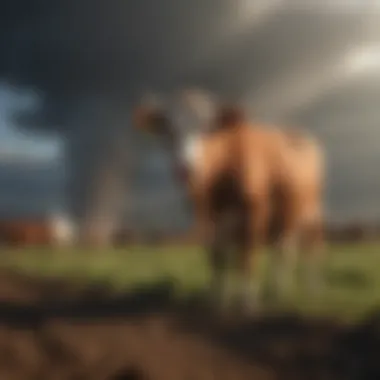Exploring Greenhouse Gas Emissions in Agriculture


Overview of the Topic
Definition and Importance
Greenhouse gases (GHGs) are compounds that trap heat in the atmosphere, contributing significantly to climate change. In agriculture, these emissions arise from various sources, impacting not only the environment but also food security and economic stability. Understanding these sources is crucial for developing effective practices aimed at reducing emissions and promoting sustainability.
Current Trends
The agricultural sector faces increasing scrutiny regarding its role in greenhouse gas emissions. Recent global initiatives emphasize a shift toward sustainable practices. This includes adopting technologies that reduce emissions, improving soil health, and utilizing advanced livestock management techniques. Farmers and agricultural enthusiasts must stay informed about these trends to adapt to the changing landscape.
Key Techniques and Practices
Step-by-Step Guide
- Soil Management: Healthy soils sequester carbon. Practices like cover cropping and no-till farming can increase organic matter.
- Fertilizer Use: Nitrogen-based fertilizers are a major source of nitrous oxide emissions. Employing precision agriculture can minimize fertilizer use and ensure its proper application.
- Waste Management: Manure management practices affect methane emissions. Composting and anaerobic digestion can effectively reduce these emissions.
- Crop Selection: Choosing cover crops or legumes can improve soil health and reduce the necessity for synthetic fertilizers.
- Livestock Feeding Strategies: Modifying livestock diets can lead to reduced methane production. For example, including feed additives that inhibit methane-forming bacteria can be effective.
Tools and Equipment Needed
- Soil Test Kits: Essential for assessing soil health and nutrient content.
- Precision Agriculture Technology: Tools like drones and GPS mapping help optimize resource use.
- Composting Systems: These can efficiently manage organic waste, reducing methane emissions from landfills.
Challenges and Solutions
Common Obstacles
Agricultural producers often face barriers such as:
- Economic Constraints: Initial costs of adopting new technologies can be high.
- Knowledge Gap: Limited access to information can hinder the implementation of sustainable practices.
- Regulatory Pressure: Compliance with evolving regulations can be daunting for farmers.
Innovative Solutions
Innovative strategies to address these challenges include:
- Government Incentives: Programs that provide financial support for sustainable practices can alleviate economic pressures.
- Educational Workshops: Collaborations with agricultural extension services can enhance knowledge and awareness of sustainable techniques.
- Community Engagement: Sharing success stories within communities can boost motivation and drive change.
"Sustainable agricultural practices are not just beneficial for the environment, they can enhance farm productivity and resilience.”
This overview of greenhouse gas sources in agriculture reveals the critical nature of these emissions and the vital need for innovative practices. As the sector evolves, embracing efficient techniques will be key to reducing the agricultural footprint on climate change.
Prelims to Greenhouse Gases
Understanding greenhouse gases is essential for anyone involved in agriculture. These gases, such as carbon dioxide, methane, and nitrous oxide, are byproducts of various agricultural practices. They trap heat in the atmosphere, leading to global warming and climate change. This article aims to unveil how agricultural activities contribute to these emissions and the importance of addressing them to protect our environment and maintain sustainable farming practices.
Defining Greenhouse Gases
Greenhouse gases are components of the atmosphere that contribute to the greenhouse effect. This phenomenon is a natural process where certain gases trap heat from the sun, keeping the Earth warm enough to sustain life. The primary greenhouse gases relevant to agriculture include:
- Carbon Dioxide (CO2): Released from soil disturbance, burning fossil fuels, and land-use changes.
- Methane (C): Produced during digestion in livestock and decomposing organic matter.
- Nitrous Oxide (N2O): Emitted from fertilized soils, particularly when synthetic fertilizers are applied.
Importance of Understanding Sources
Comprehending the specific sources of greenhouse gases in agriculture is crucial. Each farming practice has a different impact on emissions. For instance, intensive livestock farming can produce significant amounts of methane, while certain tillage practices can release carbon dioxide from soils.
Knowing these sources allows farmers and policymakers to:


- Identify reduction strategies to minimize emissions.
- Implement more sustainable agricultural practices.
- Comply with regulatory frameworks aimed at reducing the agricultural footprint on climate change.
According to the Intergovernmental Panel on Climate Change, the agricultural sector contributes approximately 25% of global greenhouse gas emissions.
Gaining insights into the origins of these gases is foundational for moving towards sustainable agriculture. By adopting improved practices, the agricultural community can mitigate its impact and contribute to global climate goals.
Agricultural Emissions Overview
Agricultural emissions are a critical area of study when exploring the overall impact of human activity on climate change. The agricultural sector is responsible for a substantial portion of global greenhouse gas emissions. Understanding this topic is essential for identifying effective strategies to reduce these emissions and for promoting sustainable farming practices. Given the increasing focus on environmental issues, farmers and agricultural enthusiasts must recognize the significance of these emissions in shaping climate policy and agricultural practices.
Global Agricultural Impact
Globally, agriculture accounts for approximately 14% of all greenhouse gas emissions. This figure may seem modest at first glance, but it encompasses various activities, including livestock production, fertilizer application, and land use changes. Each of these activities releases significant amounts of methane and nitrous oxide, which are far more potent than carbon dioxide in their warming potential.
According to reports by the Food and Agriculture Organization (FAO), livestock, particularly cattle, contribute heavily to methane emissions through enteric fermentation. This process occurs during digestion and results in the release of methane as a byproduct. Manure management also results in considerable emissions, primarily when manure is stored or treated anaerobically. Moreover, the use of fertilizers contributes significantly to nitrous oxide emissions, which are often underappreciated despite their impactful role in climate change.
The ramifications of these emissions are profound. They affect global temperatures, weather patterns, and water security. As agricultural output strives to keep pace with a growing global population, the industry must examine its practices critically and seek efficient methods that minimize its carbon footprint.
Comparative Analysis with Other Sectors
When comparing agricultural emissions to those from other sectors, the analysis reveals intriguing insights. While the energy sector remains the largest contributor overall, agriculture's emissions profile presents unique challenges and opportunities for mitigation.
- Energy Sector: This sector includes fossil fuel combustion for electricity and heat, contributing over 70% of global emissions.
- Transportation: Emissions from this domain arise primarily from the burning of fossil fuels for cars, trucks, and aircraft, accounting for about 15% of global emissions.
- Industry: The industrial sector contributes approximately 21% of total emissions through manufacturing processes and chemical reactions.
Alongside these sectors, agriculture's distinct emissions profiles lead to debates on how best to achieve reduction goals. Unlike energy or transportation, agricultural emissions result significantly from biological processes. This factor complicates the mitigation efforts since many processes are inherently tied to the lifecycle of agricultural products. However, this also opens avenues for innovative practices, such as precision agriculture and agroforestry, that can enhance sustainability while maintaining food production.
"Sustainable practices in agriculture can offer a dual benefit: mitigating climate change and ensuring food security for future generations."
Ultimately, understanding the emissions from agriculture and how they relate to other sectors is essential for developing effective policies. This holistic approach to emissions is necessary to drive forward both sustainability and food security goals.
Major Sources of Greenhouse Gases
Understanding the major sources of greenhouse gases in agriculture is critical. Agriculture plays a significant role in the emission of gases that contribute to climate change. By examining the different aspects of agricultural operations, we can identify specific improvements and adaptations that lessen these emissions. The following sections delve into five primary sources of greenhouse gases: livestock production, crop production techniques, soil management practices, fertilizer use and emissions, and land use changes. Each of these areas is essential in constructing a comprehensive approach to agricultural sustainability.
Livestock Production
Livestock production is one of the most notable contributors to greenhouse gas emissions in agriculture. Animals, particularly cattle, produce methane during digestion. Methane is a potent greenhouse gas with a global warming potential significantly higher than carbon dioxide.
Moreover, managing livestock waste is another source of emissions. If not properly handled, waste decomposes anaerobically, leading to additional methane release. Raising livestock requires significant quantities of feed, often sourced from land that could otherwise store carbon. This dynamic further complicates the environmental impact of livestock farming. Thus, addressing this challenge is vital in the broader effort to reduce agricultural emissions.
Crop Production Techniques
The techniques employed in crop production have varying impacts on emissions. Conventional methods, often reliant on heavy machinery and high levels of chemical inputs, lead to increased fossil fuel use. This significantly contributes to carbon dioxide emissions.
On the other hand, practices such as crop rotation and no-till farming can reduce emissions by enhancing soil health and reducing the need for tilling, which often releases stored carbon. The choice of crops can also influence emissions. Certain crops require less input and can fix nitrogen, which minimizes the need for synthetic fertilizers. Therefore, selecting appropriate crop production techniques is key in reducing the agricultural carbon footprint.
Soil Management Practices
Soils have a crucial role in the emission and absorption of greenhouse gases. Poor soil management can lead to carbon loss and increased emissions of nitrous oxide, another potent greenhouse gas.
Soil practices such as cover cropping, proper grazing management, and reduced tillage can enhance carbon sequestration and minimize emissions. Healthy soils can act as carbon sinks, offsetting some of the emissions from agricultural operations. Thus, investing in effective soil management practices can yield both environmental and productivity benefits.
Fertilizer Use and Emissions


Fertilizers are essential in modern agriculture but are also significant sources of greenhouse gases. The application of nitrogen-based fertilizers can lead to the release of nitrous oxide, a greenhouse gas many times more potent than carbon dioxide.
To mitigate this issue, farmers can adopt precision agriculture techniques. Such methods allow for more accurate fertilizer application, minimizing excess and reducing emissions. Additionally, exploring organic alternatives to synthetic fertilizers may provide pathways to lower emissions while maintaining crop yields.
Land Use Changes
Land use changes due to agriculture are a formidable source of greenhouse gases. Converting forests or wetlands into agricultural land not only releases stored carbon but also diminishes the land's ability to absorb carbon in the future.
Sustainable land use practices involve improving the data on forest and wetland restoration, agroforestry systems, and maintaining existing ecosystems. While the demand for agricultural products continues to rise, strategic land management is necessary to balance production with environmental sustainability.
Summary: Major sources of greenhouse gases in agriculture are diverse, spanning livestock production, crop techniques, soil practices, fertilizer application, and land use changes. Recognizing these will help develop strategies crucial to tackling greenhouse gas emissions in the agricultural sector.
Specific Greenhouse Gases Identified
Understanding the greenhouse gases specifically associated with agriculture is crucial for addressing climate change. In this section, we will focus on three primary gases: carbon dioxide, methane, and nitrous oxide. Each of these gases has unique sources, properties, and impacts on the environment. Recognizing their significance allows for targeted mitigation strategies within the agricultural sector. Moreover, it provides insights into how farmers can adapt practices to reduce their carbon footprint.
Carbon Dioxide Emissions
Carbon dioxide is a predominant greenhouse gas emitted from agricultural activities. Its origins can be traced to various sources. The combustion of fossil fuels in machinery, transport, and processing contributes significantly to carbon emissions. Farmers often rely on tractors, harvesters, and other equipment, which generate emissions from diesel or gasoline. Shifting to more efficient machinery can reduce this impact.
Deforestation and land-use changes for agriculture also release carbon dioxide. When forests are cleared, the stored carbon is released into the atmosphere. This practice not only affects biodiversity but also contributes to increasing greenhouse gas concentrations. Preserving existing forests and implementing sustainable land management can help mitigate these emissions.
Moreover, soil management plays a role. Practices that lead to soil degradation increase carbon loss from the soil. Adopting methods such as cover cropping and reduced tillage can enhance soil carbon sequestration, effectively capturing carbon dioxide that would otherwise enter the atmosphere.
Methane Emissions from Agriculture
Methane is another significant greenhouse gas, emitted primarily through livestock digestion and the management of organic waste. Ruminant animals, such as cows and sheep, produce methane during digestion through a process called enteric fermentation. This process leads to significant methane emissions, making livestock production a key contributor.
In addition, the handling and storage of manure can produce methane as organic matter decomposes. Waste management practices, such as anaerobic digestion, can capture methane and convert it into energy, reducing its release into the environment.
Rice cultivation is a notable source of methane as well. Flooded rice fields create anaerobic conditions that promote methane production. Adjusting irrigation practices can minimize these emissions and is critical for sustainable rice production.
Nitrous Oxide Contributions
Nitrous oxide represents a smaller but vital part of agricultural emissions. This gas primarily originates from the use of nitrogen-based fertilizers. When these fertilizers are applied to crops, microorganisms in the soil convert some of the nitrogen into nitrous oxide, a gas with a much higher global warming potential than carbon dioxide.
Improper application rates and timing of fertilizers can exacerbate nitrous oxide emissions. Using precision agriculture techniques can optimize fertilizer use and minimize losses. Cover crops and organic amendments can also help improve soil health while reducing the need for synthetic fertilizers.
Soil management and crop rotation practices can foster microbial activity that enhances nutrient cycling, effectively suppressing nitrous oxide emissions from soil.
"Understanding and managing the specific greenhouse gases associated with agriculture is vital for sustainable practices."
Mitigation Strategies in Agriculture
Mitigation strategies in agriculture play a critical role in addressing the pressing issue of greenhouse gas emissions. The agricultural sector is a significant contributor to climate change, but it also holds the potential for impactful solutions. Understanding these strategies can help in reducing emissions while maintaining productivity. Implementing effective mitigation practices allows farmers to enhance sustainability and protect the environment.
Adopting Sustainable Practices
Sustainable agricultural practices focus on reducing environmental impacts while supporting food production. These practices include crop rotation, cover cropping, and reduced tillage. They help improve soil health, increase biodiversity, and store carbon in the soil.
- Crop Rotation: This method reduces pests and diseases, leading to lower dependence on chemical inputs.
- Cover Cropping: Planting cover crops increases soil organic matter and prevents erosion.
- Reduced Tillage: Minimizing soil disturbance can enhance carbon sequestration and improve soil structure.
These sustainable methods contribute to significant reductions in carbon dioxide emissions and promote long-term environmental health.


Utilizing Technology for Emission Reduction
Technology offers various innovative solutions to curb greenhouse gas emissions in agriculture. Precision agriculture and biotechnology are vital in this regard.
- Precision Agriculture: This technology uses data analysis to optimize inputs like water and fertilizers. It leads to lower emissions by ensuring resources are used more efficiently.
- Biotechnology: Genetically modified organisms (GMOs) can produce crops that require less fertilizer and are more resilient to environmental stress. This reduces the overall fertilizer usage, further cutting down on nitrous oxide emissions.
Farmers who adopt these technologies can enhance their productivity while mitigating environmental impacts.
Policy Interventions and Global Agreements
Policy interventions are essential for fostering a conducive environment for emission reduction in agriculture. Governments and international organizations can enact regulations and incentives that promote sustainable practices.
- Subsidies for Sustainable Practices: Financial support can encourage farmers to adopt eco-friendly practices.
- Carbon Trading Systems: These systems allow farmers to sell carbon credits for the emissions they reduce, providing an economic incentive for mitigation strategies.
- International Agreements: Frameworks like the Paris Agreement focus on global cooperation to reduce greenhouse gas emissions. Countries can set targets that encourage more sustainable agricultural practices.
"Effective policy can drive the agricultural sector towards a greener, more sustainable future."
Emerging Trends in Sustainable Agriculture
The topic of emerging trends in sustainable agriculture is central to our understanding of greenhouse gas emissions in the agricultural sector. Farmers and enthusiasts are increasingly focusing on practices that not only maintain productivity but also reduce the environmental impact. These trends are significant because they offer innovative ways to address the pressing challenge of climate change while promoting economic viability. In this section, we will explore three key areas: agroecological practices, organic farming techniques, and integrating renewable energy sources.
Agroecological Practices
Agroecological practices emphasize biodiversity, ecosystem health, and sustainable land use. These methods aim to create a balance in natural systems and minimize the reliance on synthetic inputs. Farmers implementing agroecology often rotate crops, maintain cover crops, and integrate livestock into their farming systems.
Benefits include reduced soil erosion, improved water retention, and enhanced soil fertility. These practices contribute to carbon sequestration, thereby reducing overall greenhouse gas emissions. Furthermore, they support local food systems and can increase resilience against climate variability. By operating within ecological limits, agroecological practices promote a sustainable food system that benefits both farmers and the environment.
Organic Farming Techniques
Organic farming techniques focus on producing food without the use of synthetic fertilizers and pesticides. This method promotes the use of natural inputs, such as compost and green manure, to enrich the soil. Organic farms often employ crop rotation and polyculture to enhance biodiversity and improve soil structure.
These practices help in reducing nitrous oxide emissions, a potent greenhouse gas associated with conventional fertilizer use. Moreover, organic farming reduces reliance on fossil fuels, as it often involves less industrial machinery and transport. By maintaining healthy ecosystems, organic farming not only lowers emissions but also improves community health by providing consumers with cleaner food options.
Integrating Renewable Energy Sources
Integrating renewable energy sources within agricultural operations presents a promising route towards sustainability. Farmers are increasingly adopting solar panels and wind turbines on their farms. These energy sources can power equipment, irrigation systems, and even farm buildings without resulting in additional emissions.
Switching to renewable energy helps in reducing dependency on fossil fuels, a significant contributor to greenhouse gases. Additionally, some farms generate excess energy and can sell it back to the grid, creating a new revenue stream. Using renewable energy aligns well with sustainable farming principles, leading to both lower emissions and increased economic resilience.
"The future of agriculture lies in its ability to innovate, adapt, and promote sustainability through new practices and technologies."
Culmination and Future Directions
Understanding the sources of greenhouse gases in agriculture is paramount for any effort aimed at tackling climate change effectively. Agriculture not only contributes significantly to overall emissions but also plays a crucial role in providing solutions to mitigate its own impact. This section synthesizes the core findings of this article and emphasizes the path forward for sustainable agricultural practices.
Summary of Findings
The article has comprehensively investigated the major sources of greenhouse gases in the agricultural sector. Key contributors include:
- Livestock Production: This sector is responsible for methane emissions through enteric fermentation and manure management.
- Crop Production Techniques: Certain methods such as monocropping increase susceptibility to diseases and pests, driving up the need for chemical inputs that contribute to emissions.
- Soil Management Practices: The handling of soil can significantly impact carbon storage capacity, with poor practices releasing carbon dioxide instead.
- Fertilizer Use and Emissions: Nitrous oxide emissions arise mainly from nitrogen fertilizers, which are vital for crop yield but need careful management.
- Land Use Changes: Converting forests to agricultural land can release vast amounts of carbon stored in trees, exacerbating emissions.
These findings reveal the imperative need for sustainable agricultural practices to reduce greenhouse gas emissions while ensuring food security.
Call for Continued Research and Policy Innovation
Ongoing research and adaptation of policies are essential for both mitigating agricultural emissions and promoting sustainability. This involves:
- Investing in Research: Further studies can help uncover innovative agricultural practices that minimize emissions and enhance carbon sequestration.
- Promoting Policy Frameworks: Governments need to craft policies that encourage farmers to adopt sustainable practices, offering incentives that make such methods financially viable.
- Enhancing Collaboration: Partnerships between researchers, farmers, and policymakers are vital for implementing effective strategies that address emissions at all levels.
"Continuous improvement in farming method can lead to a sustainable future for agriculture and the environment simultaneously."
Addressing the challenges of greenhouse gas emissions in agriculture requires a comprehensive approach, leveraging technology and sustainable practices to ensure long-term viability for both the industry and the planet. The task at hand is serious and demands collective effort, innovative policies, and a commitment to sustainability.



